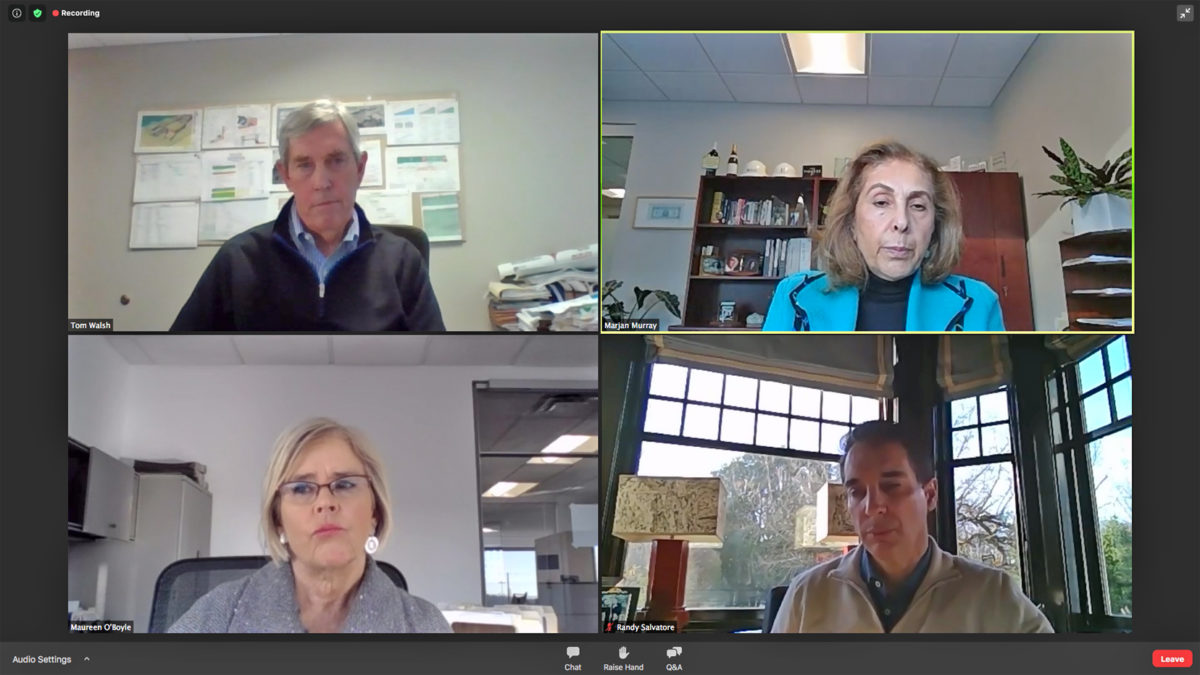Having dealt with the Covid-19 pandemic better than most states ”” at least so far ”” Connecticut is poised to rebound and become stronger than ever if certain conditions are met.
That was the main theme of the Construction Institute”™s annual Fairfield County Economic Forum, held virtually this year on Dec. 3. Panelists from the banking, brokering, development and construction fields agreed that the Covid-caused migration from New York to Fairfield County has been a net positive ”” though they warned that significant challenges remain.
Thanks to that migration, “There are segments of the real estate industry that are doing very well,” said People”™s United Bank Executive Vice President Marjan Murray, “including industrial and self-storage. Multifamily has been stable, and single-family has been on fire.”

Murray also credited the federal government”™s Paycheck Protection Program (PPP) with helping to stabilize the nation”™s economy. “It was very effective ”” they basically put a floor under the economy,” she said.
The Bridgeport-based bank processed 18,500 PPP loans totaling $2.6 billion, Murray said. Another, much-hoped-for coronavirus relief bill ”” a $908 billion package was reportedly in the works on Dec. 7 ”” from the federal government would greatly help small businesses that are still hurting, she said.
That point was echoed by Randy Salvatore, founder and CEO of RMS Cos. in Stamford. Although his company operates five boutique hotels, such businesses in general are in serious peril, as are the companies that service them.
“We don”™t need high occupancy (at RMS”™ hotels to survive),” Salvatore said. “But it”™s very different for the restaurants that service those types of places. A lot of people don”™t want to eat indoors, and you have capacity concerns.” Without additional government aid over the next few months, he said, “Hotels are going to be a challenge.”
The influx of new residents presumably paying their share of taxes will be “a major driver for the economy,” said moderator Tom Walsh, executive vice president at Stamford-based A.P. Construction Co.
“Population growth is always good for the state,” Murray agreed.
On the commercial side, however, the picture is a bit fuzzier, according to Maureen O”™Boyle, managing director, brokerage services at Cushman & Wakefield. While a fair number of hedge funds have taken office space in Stamford, those spaces are smaller than normal, averaging 5,000 to 10,000 square feet, she said. One firm is currently negotiating for a 25,000-square-foot facility in Greenwich, she said.
The great unknown is the future of working from home as opposed to returning to the office, O”™Boyle said. “Corporations are downsizing by 20-25%,” with the result being a flood of subleasing deals.
Some corporations are going to landlords as much as three years ahead of their lease”™s expiration and saying they”™re willing to commit to early renewal in exchange of giving up 20% to 25% of their space, she said. Others are looking to expand their space in order to accommodate large numbers of returning employees at the proper social distance.
But “I”™m not a firm believer that people are really happy working remotely,” O”™Boyle said. “I think people as a whole, especially younger people, want to be around each other to collaborate, to socialize. I don”™t think you can continue to grow a corporate culture working remotely.”
The construction side has been “fairly unaffected” by the pandemic, Salvatore said, given that the sector was deemed essential from the start. Costs have risen slightly due to safety protocols and supply chain management can be sometimes difficult, he said: “It”™s a matter of staying ahead of those things.”
Even with such gains, however, “Fiscally, we continue to be a weak state,” Murray said. Part of that is due to the costs of dealing with Covid-19, but what Salvatore called “pre-existing conditions” ”” primarily the state”™s still significant pension liabilities ”” also remain a stumbling block moving forward.
But, he said, if the state “can right the ship and we don”™t go down that path again, then Connecticut can really differentiate itself” from other states.
As goes NY, so goes CT
All agreed that a strong New York remains key to Connecticut”™s own economic success.
“If New York does not come back,” Salvatore said, “people have so many options without the high costs of living in Connecticut,” thanks to ever-evolving technology.
However, he said, “If things continue to go well, and Connecticut continues to become more business-friendly,” not only will Fairfield County benefit, but so too will places like Hartford and New Haven, as migrations continue northward.
“Once you”™re here, you”™re going to stay here,” O”™Boyle said, given the affordable quality of life Fairfield County can offer that much of New York City cannot. Even so, she said, it will probably be 2025 before New York City really comes back.
The lending process is also transforming, Murray said. While what she called the “Four C”™s” of lending ”” credit, character, collateral and cash flow ”” are remaining constant, defining those is not necessarily as simple as it once was. Lenders are being more careful in analyzing proposals, with cash flow particularly difficult to determine at the present time.
“They”™re the same criteria, but they”™re looking a little harder at different scenarios,” Salvatore agreed. “A lot of borrowing and lending is relationship based. There will always be money out there for a good project, but if you”™ve never done a deal or had a relationship with a particular lender, I don”™t think they”™re going to talk to you right now.”
Similarly, he said, “if we would want to do a hotel right now, that would be a very short conversation.”
O”™Boyle said that the uncertainty extends to commercial leases. What percentage of tenants are paying rent ”” or are making late payments or not paying rent at all ”” while always important, has become a critical question. If a building goes into foreclosure due to such issues within a year of a tenant signing a lease, “that”™s a big problem for the tenant, and for us.”
In addition, she said, the average building in Fairfield County is about 30 years old, “so most of their infrastructure is coming to the end of their useful life.” While the costs of repairs can be passed on to tenants, she questioned whether the same could be done with wholesale HVAC improvements. “How does a building”™s HVAC work ”” is it by floor or the entire building?” she asked. “What safety accommodations are the landlords investing in?”
While health care systems are saddled with “huge expenses” in fighting the virus, O”™Boyle said, “You can”™t keep cutting costs to the point where you go out of business.” As a result, hospitals will likely come to rely even more on philanthropic donations as they continue the trend toward directing patients to smaller, off-campus ambulatory services.
“I call it health care warfare ”” Yale against Nuvance against Hartford Health,” she said. “But competition”™s good and the strongest will survive.”
High-end retail will “also get hurt,” Murray said. “Those rents have to come down” if they are to survive.
On the other hand, Walsh said, country clubs are suddenly rebounding. “People are playing more golf, young families want to join and the country clubs are starting to regenerate and compete with each other again. There”™s an upswing” in applications both to country clubs and to private schools, he said.
Looking at a post-Covid future, Salvatore predicted that hotel demand “will probably decrease permanently,” but the possibility of converting at least part of those properties into commercial or residential will be tantalizing.
“This is a unique opportunity,” Salvatore said. “Growth leads to more growth if it”™s done properly.”






















